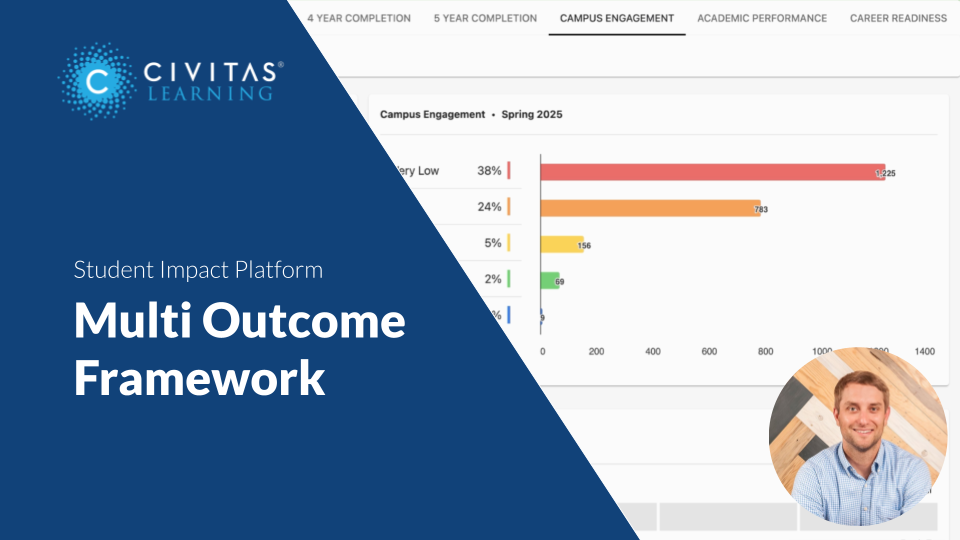
Accelerate Student Outcomes with AI-Powered Adaptable Analytics
Share this Post
SUMMARY: Adaptable analytics empowers higher education leaders with real-time, actionable insights that evolve with changing circumstances, enabling smarter decisions, more effective planning, and stronger team collaboration to proactively support student success.
In higher education, making timely, data-informed decisions to support students isn’t easy. The information you need is often scattered across systems, buried in static reports, or hard to translate into action. Whether you’re helping one student get back on track or trying to uncover systemic issues affecting entire groups, the key is having clear, actionable insights you can trust.
That’s where Adaptable Analytics comes in. With cutting-edge predictive and generative AI capabilities, Civitas Learning makes it easier to get answers to your most important questions. With our suite of AI-powered tools, Civitas Learning helps you to quickly get the information that matters, so that you can respond faster, plan smarter, and support student success at every level.
We call this “adaptable analytics” because it not only evolves in real time with your data, but also adapts to your institution’s priorities, challenges, and context. Unlike static, one-size-fits-all models, adaptable analytics use your institution’s data to uncover nuanced patterns often missed by standard tools, ensuring you focus on what matters most, precisely when it matters.
From Individual Support to Institutional Impact
Whether identifying at-risk students or exploring broader questions, like which student groups struggle to persist or which courses contribute to drop rates, adaptable analytics help you surface the right insights to action. It’s a core feature of the Civitas Learning Student Impact Platform, built to help institutions uncover what’s influencing student behavior and spot opportunities to deliver more effective support.
How It Works
Adaptable analytics combines predictive and generative AI to power timely, confident decision-making:
- Predictive AI to anticipate student needs using institution-specific models
- Generative AI to streamline tasks and decisions within connected, intelligent workflows
This combination helps answer complex questions in real time, such as:
- Is Anna attending class regularly?
- What’s most likely affecting her persistence?
- How can we boost LMS engagement?
By surfacing the right insights at the right time, adaptable analytics allows you to spend less time managing systems and more time supporting students where it matters most.
Four Ways Adaptable Analytics Drives Outcomes
Turning data into actionable, accessible insights and getting it to the right people is a challenge many institutions face. In today’s fast-paced environment, leaders require a clear and comprehensive understanding of their students and institution to provide timely and effective support.
Adaptable analytics simplifies that process. Here are four ways it helps drive results:
- From Reactive to Proactive Support
Traditional analytics in higher education often rely on static, scheduled outputs like mid-semester grades, providing only periodic snapshots of student performance. In contrast, adaptable analytics offers real-time insights tailored to an institution’s specific needs. By integrating data from multiple sources, such as Student Information Systems (SIS), Learning Management Systems (LMS), career platforms, and case management systems, institutions can regularly assess the effectiveness of interventions and immediately apply findings to enhance decision-making and student outcomes.
For example, this analysis can generate predictions, refine them over time, and adjust support strategies based on student responses and emerging data patterns—well before grades indicate a need for help. This process runs continuously, so stakeholders can intervene before the course concludes.
- Precise Insights for Faster Responses
Adaptable analytics are generated from models built for your specific institution and continuously adjust based on new information, like shifts in student engagement or performance. They are always adapting and learning to become more and more precise and understand what influences student outcomes at your institution.
Where traditional tools flag broad indicators like a GPA below 2.0, adaptable analytics can go deeper, spotting, for example, that students who earn a C in English 1101 are more likely to fall behind. This level of precision allows advisors to dynamically group students based on real-time performance and context, scale personalized outreach, and monitor progress over time.
This analysis helps institutions move beyond one-size-fits-all support and diversify how they deliver support by personalizing how they engage with students. Leaders and their teams can monitor changes in persistence and adjust their outreach accordingly. With generative AI, they can quickly create personalized content, like messages and resources, boosting the efficiency of support services. AI-powered platforms let staff ask questions and get immediate, relevant answers without digging through dashboards or reports.
- Coordinate Support to Help Students Thrive
Institutional research teams often generate valuable insights—but those insights are usually siloed, available only to the department that requested them. To better support students, especially those hesitant to ask for help, institutions need to make these insights accessible across teams, with the right permissions in place. This collaboration flags potential issues early and fosters more meaningful interactions. Instead of starting from scratch, staff can use data to spot potential challenges and guide students toward the right support.
For example, if Psychology 110 is a required course for both business and English majors and becomes a bottleneck, that insight shouldn’t live in just one department. With a shared view of the issue, academic leaders can coordinate solutions, like adding tutoring, adjusting course availability, or offering supplemental instruction.
At Slippery Rock University (SRU), adaptable analytics helped shape targeted programming for undeclared business majors. By connecting these students with career services and alumni, SRU helped them clarify their goals and academic paths. The data also showed that students who met with an advisor at least twice were more likely to persist. Adaptable analytics surface these intersecting patterns—like major status and advising frequency—so institutions can take action and improve outcomes where it matters most.
- Assess Initiatives to Identify What Works
Higher education leaders understand that student success initiatives are essential, but the real impact comes from knowing which programs work for which students. With adaptable analytics, institutions can measure program effectiveness and predict which students will most likely benefit, enabling more targeted, efficient outreach and support through connected workflows.
Establishing a system for regular initiative assessment is key to driving better outcomes. The University of Texas at San Antonio (UTSA) is a strong example. Using initiative analysis within the Civitas Learning Student Impact Platform, UTSA evaluated its Student Success Coaching program and uncovered a critical insight: coaching significantly boosted persistence among at-risk students who were previously unlikely to engage. Combined with broader strategies, this insight helped UTSA achieve a 16% increase in retention and a 14% increase in completion from 2012 to 2022.
Final Thoughts
Adaptable Analytics helps higher education leaders make smarter, faster decisions by turning complex student data into timely, actionable insights. By combining predictive and generative AI within connected workflows, institutions can deliver proactive, personalized support that evolves with student needs, leading to better outcomes, more efficient teams, and a stronger student experience.

